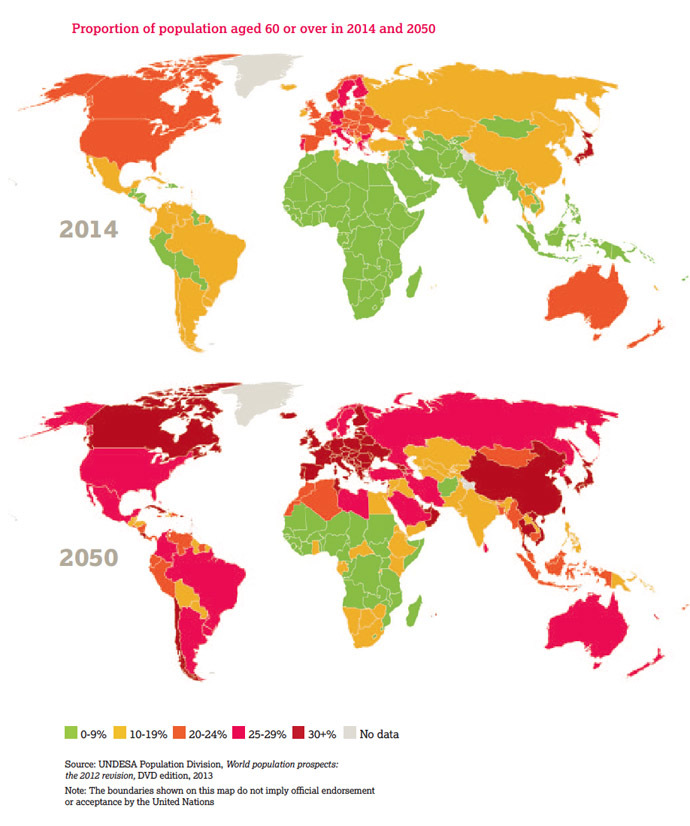Surge in seniors: Elderly to constitute 20% of world population by 2050

By 2050, the elderly are set to comprise 20 percent of the global population. National governments should therefore be getting ready to expand pensions and ensure good living conditions for the elderly, a recent report stated.
The data was published in the 2014 GlobalAgeWatch Index report.
Two billion older people are expected to represent one-fifth of the world population in 2050. Current numbers are over 850 million of the elderly across the globe – 12 percent of the global population.
The report provides statistics on the history of the issue and what caused the modern concerns in the first place: for example, in many countries, life expectancy at 60 is now over 30 percent higher than it was in the mid-20th century. Also, pensions aren’t as widespread as the citizens of the developed countries may suppose: in low- and middle-income countries, only one in four people over 65 receive a pension.
Countries where the elderly are considered advantaged include Norway, Sweden, Switzerland, Canada and Germany. On the other hand, the ones ranked the lowest are Afghanistan, West Bank and Gaza, and Mozambique.
“This is an unprecedented phenomenon in human history; the rapid rise in the proportion of older people in society,” Chris Roles, director of Age International, told the Guardian.
“The report points to the urgency of a whole range of policies that are needed,” he added.
The report also underlined the need to change the approach towards the policies regarding people over 60.

Almost all countries have a sort of pension system. However, over the past 20 years a sharp increase of new tax-financed ‘social’ pensions, existing in over 100 countries nowadays. These payments are aimed at creating an income for the least well-off pensioners. In 2009, China launched the program of a rural social pension covering 133 million people. Other countries in Asia including Nepal and Thailand followed suit.
According to the report, this development signifies a dramatic change in pension policy priorities: earlier, contributory pensions were the main choice.
However, in less-developed countries with low and middle incomes, it didn’t meet the needs of a large percentage of population: many citizens had precarious jobs, without access to formal pension plans.
Even for the now growing ‘fragile middle’, saving isn’t an option due to low incomes.
Most recently, the shift from contributory to social pensions happened in Mexico and Peru. In the former, contributory payments introduced in 1943 only cover 25 percent of the citizens, but social pensions that have appeared over the past ten years allowed for almost nine out of 10 elderly over 65 being covered.
In Peru, a similar program was launched. For instance, 74-year-old Juana Huamaní Bautista became eligible for the $89 monthly pension, which isn’t much, but gives sufficient independence.
“Now I don’t have to worry so much about money. Whenever I get sick, I can buy medicine without asking my children,” she said in the report.

The question raised by GlobalAgeWatch Index 2014, though, is whether a country can afford to allow all of its elderly to receive social pensions. Research has shown that if people over 65 were paid 20 percent of their former income, it would cost from 0.4 percent of GDP in Burkina Faso to 1.8 percent in China. Despite rather low costs for the budget, the report concludes that only 50 percent of the elderly can now hope for a “social protection floor”– which is still considered essential, and not only in rich countries.
All in all, GlobalAgeWatch Index 2014 stressed the need that nowadays, life doesn’t end at 60 – or 70 and 80, for that matter. Thus, new policies should be introduced all over the world if we want stability and well-being for people over 60.
“People do not stop developing when they reach 60 or 70 or 80. Our older years should be as much a time to expand our horizons as our earlier years. Supporting older people will help to create a world where all feel confident to live with dignity and security,” the report said.














